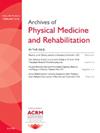Mobility Simulation: An IPL Opportunity 4349
IF 3.6
2区 医学
Q1 REHABILITATION
Archives of physical medicine and rehabilitation
Pub Date : 2025-04-01
DOI:10.1016/j.apmr.2025.01.051
引用次数: 0
Abstract
Objectives
To evaluate the impact of interprofessional simulation on student perception of interprofessional collaborative competencies.
Design
The interprofessional simulation learning activity took place. The recruitment script/consent was read. They had access to a QR code link to the Interprofessional Collaborative Competencies Attainment Survey (ICCAS) through Microsoft Forms available on the SVSU OneDrive. Participants were asked to identify their professional program of study (Nursing or Occupational Therapy). No other demographic information was collected. The tool selected was the Interprofessional Collaborative Competency Attainment Scale (ICCAS). The ICCAS was developed by MacDonald, C., Archibald, D., Trumpower, D., Casimiro, L., Cragg, B., & Jelly, W. (2010). The ICCAS is a 20 item retrospective pre/post designed self-assessment. Participants complete the tool only once at the conclusion of the simulation event. All items are positively worded and the participant is asked to rate their ability before and after activity with a score from 1 (strongly disagree) to 7 (strongly agree). The University of Ottawa's methodology for administering the ICCAS was used. Data were analyzed using SPSS. Paired t tests were performed on presimulation and postsimulation responses for each item of the ICCAS to evaluate perceived changes to interprofessional competencies.
Setting
This study was conducted at a public university in the United States.
Participants
Thirty-nine nursing students and 32 occupational therapy students completed the ICCAS tool after the simulation activity.
Interventions
The 3 simulations were designed using Society for Simulation in Healthcare best practices guidelines. Nursing and Occupational Therapy faulty had equal voice in planning and setting the objectives for the simulations. Objectives were reviewed with all participants. Participants were given presimulation information. Participants had time to ask questions and permission to step out of the simulation activity if they became stressed. Participants rotated to all 3 simulations, a newborn with a 100% brachial plexus injury, a 65-year-old ventilator dependent patient, and a home care patient with posttraumatic stress disorder. Participants participated in debriefing after each simulation activity.
Main Outcome Measures
The outcome of the study was to evaluate the effectiveness of an interprofessional simulation to improve student interprofessional collaboration and teamwork.
Results
Using the ICCAS data, all 20 mean post simulation item scores were greater than preprogram counterparts. All students and each preprofessional group reported improved levels of interprofessional collaborative competence.
Conclusions
Results support that simulation can impact students’ perceived level of collaborative competencies. The study adds to the body of knowledge that regular exposure to IPE during prelicensure programs may help embed collaborative practice as an integral part of health professionals’ practice.
Disclosures
none.
移动模拟:IPL机会4349
目的探讨跨专业模拟对学生跨专业协作能力感知的影响。设计进行跨专业模拟学习活动。阅读了招募脚本/同意书。他们可以通过SVSU OneDrive上的微软表格访问到跨专业协作能力成就调查(ICCAS)的QR码链接。参与者被要求确定他们的专业学习计划(护理或职业治疗)。没有收集其他人口统计信息。选择的工具是跨专业协作能力成就量表(ICCAS)。ICCAS是由MacDonald, C., Archibald, D., Trumpower, D., Casimiro, L., Cragg, B.,和;杰里,W.(2010)。ICCAS是一个有20个项目的回顾性的事前/事后设计的自我评估。参与者只在模拟活动结束时完成一次工具。所有的项目都是积极的措辞,参与者被要求在活动前后用1分(非常不同意)到7分(非常同意)来评价他们的能力。采用了渥太华大学管理ICCAS的方法。数据采用SPSS进行分析。对ICCAS每个项目的模拟前和模拟后的反应进行配对t检验,以评估对跨专业能力的感知变化。本研究是在美国一所公立大学进行的。参与者39名护理专业学生和32名职业治疗专业学生在模拟活动后完成了ICCAS工具。干预措施3个模拟是根据医疗保健模拟学会最佳实践指南设计的。护理学和职业治疗学在规划和设定模拟目标方面有同等的发言权。与所有参与者一起审查目标。参与者被告知预模拟信息。参与者有时间问问题,如果感到压力,他们可以退出模拟活动。参与者轮流参加所有3个模拟,一个是100%臂丛损伤的新生儿,一个是依赖呼吸机的65岁患者,一个是创伤后应激障碍的家庭护理患者。每个模拟活动结束后,参与者都参加了汇报。主要结果测量本研究的结果是评估跨专业模拟对改善学生跨专业协作和团队合作的有效性。结果使用ICCAS数据,模拟后的20项平均得分均高于程序前的得分。所有学生和每个职前小组都报告了跨专业合作能力的提高。结论实验结果支持模拟对学生协作能力感知水平的影响。该研究增加了知识体系,即在执照预备课程期间定期接触IPE可能有助于将合作实践作为卫生专业人员实践的一个组成部分。
本文章由计算机程序翻译,如有差异,请以英文原文为准。
求助全文
约1分钟内获得全文
求助全文
来源期刊
CiteScore
6.20
自引率
4.70%
发文量
495
审稿时长
38 days
期刊介绍:
The Archives of Physical Medicine and Rehabilitation publishes original, peer-reviewed research and clinical reports on important trends and developments in physical medicine and rehabilitation and related fields. This international journal brings researchers and clinicians authoritative information on the therapeutic utilization of physical, behavioral and pharmaceutical agents in providing comprehensive care for individuals with chronic illness and disabilities.
Archives began publication in 1920, publishes monthly, and is the official journal of the American Congress of Rehabilitation Medicine. Its papers are cited more often than any other rehabilitation journal.

 求助内容:
求助内容: 应助结果提醒方式:
应助结果提醒方式:


